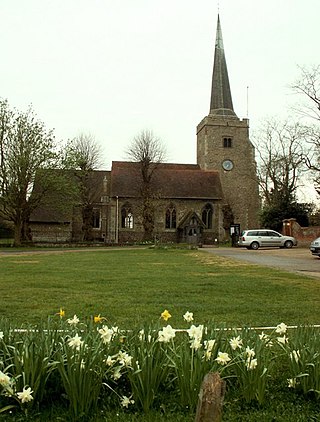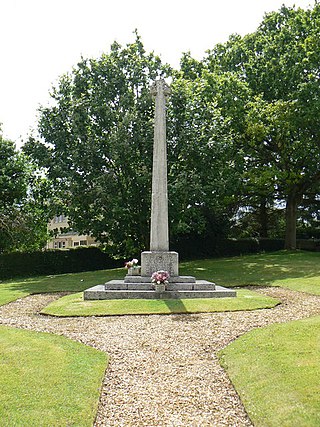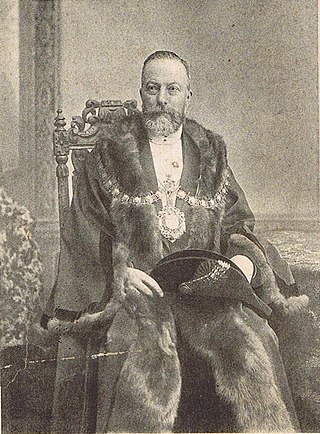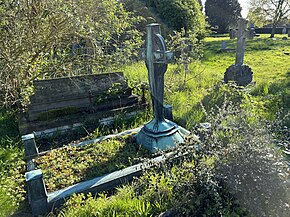
Chelmsford is a city in the City of Chelmsford district in the county of Essex, England. It is the county town of Essex and one of three cities in the county, along with Colchester and Southend-on-Sea. It is located 30 miles north-east of London at Charing Cross and 22 miles south-west of Colchester. The population of the urban area was 110,625 in the 2021 Census, while the wider district has 181,763.

Great Baddow is an urban village and civil parish in the Chelmsford borough of Essex, England. It is close to the city of Chelmsford and, with a population of over 13,000, is one of the largest villages in the country.

Danbury is a village in the City of Chelmsford district, in the county of Essex, England. It is located 33.5 miles (53.9 km) northeast of Charing Cross, London and has a population of approximately 6,500. It is situated on a hill 367 feet (112 m) above sea level.

The City of Chelmsford is a local government district with borough and city status in Essex, England. It is named after its main settlement, Chelmsford, which is also the county town of Essex. As well as the settlement of Chelmsford itself, the district also includes the surrounding rural area and the town of South Woodham Ferrers.

Harwich was a parliamentary constituency represented in the House of Commons of the Parliament of the United Kingdom until its abolition for the 2010 general election.

Chelmsford is a constituency in Essex represented in the House of Commons of the UK Parliament since 2017 by Vicky Ford of the Conservative Party.
Chelmsford City Council in Essex, England is elected every four years. Since the last boundary changes in 2003 the council has comprised 57 councillors elected from 24 wards.
The West Ham Charity Cup was an annual amateur football tournament which was contested by teams from West Ham and the surrounding area, an area of Essex that is now part of London. Only players that lived locally were eligible to compete. The competition was founded as the West Ham Hospital Cup in 1885 by George Hay, Mayor of the County Borough of West Ham, to raise funds for the local hospital, and ran until 1931.
Great Baddow High School is a comprehensive secondary school in Chelmsford, Essex, England. It is a sports college with academy status and with science as a second specialism. It draws its students from primary schools in the Chelmsford area.

The River Chelmer flows entirely through the county of Essex, England; it runs 40 miles (64 km) from the north-west of the county through Chelmsford to the River Blackwater, near Maldon.

Walter Duffield was a pastoralist and politician in colonial South Australia, Treasurer of South Australia 1865 to 1867.

Herbert James Maryon was an English sculptor, conservator, goldsmith, archaeologist and authority on ancient metalwork. Maryon practiced and taught sculpture until retiring in 1939, then worked as a conservator with the British Museum from 1944 to 1961. He is best known for his work on the Sutton Hoo ship-burial, which led to his appointment as an Officer of the Order of the British Empire.

The University of Reading War Memorial is a clock tower, designed by Herbert Maryon and situated on the London Road Campus of the University of Reading. Initially designed as a First World War memorial and dedicated in June 1924, it was later expanded in scope to also serve as a memorial of later wars.
The works of Herbert Maryon (1874–1965) were made in a variety of mediums. They were intended to be decorative, functional, or commemorative, and were primarily made during the first four decades of the twentieth century, a span that marked the first half of Maryon's career. In addition to being a sculptor and a goldsmith, Maryon was also an archaeologist, conservator, author, and authority on ancient metalwork—he saw his career as an artist carry him through the Second World War; a second career as a conservator at the British Museum brought him note for his work on the finds from the Sutton Hoo ship-burial.
Herbert William Looker was the Conservative MP for the South East Essex constituency from 1924 to 1929.
William Parry was an English footballer who played as a left half-back. He played in the Football League for Leeds United, and spent many years in non-league football either side of the Second World War.

The East Knoyle War Memorial is a monument that commemorates the lives of soldiers from East Knoyle, Wiltshire, England, who were killed in war. Unveiled on 26 September 1920, it was originally intended to commemorate the 20 soldiers from the parish who died during the First World War. Subsequent inscriptions were added to recognise twelve who were killed in the Second World War, and a soldier killed by friendly fire in the Iraq War. In 2016 the memorial was designated a Grade II listed building.

Frederic Chancellor, was an English architect and surveyor who spent much of his career working in Chelmsford, Essex, and its surrounding areas. His works included private houses, municipal buildings, churches, parsonages, banks and schools. It was during his later career that he concentrated on ecclesiastical buildings for which he became best known. A prolific architect, around 730 buildings have been attributed to him, 570 of which are in Essex.

St Mary's Church is an active parish church in the village of Great Baddow, Essex, England. The church stands on the High Street in the centre of the village and dates from the 12th century. Much extended in the 16th century, and heavily restored in the 19th and 20th centuries, the church is a Grade I listed building.
Statue of Industry was a 1929 sculpture by the English artist Herbert Maryon.















